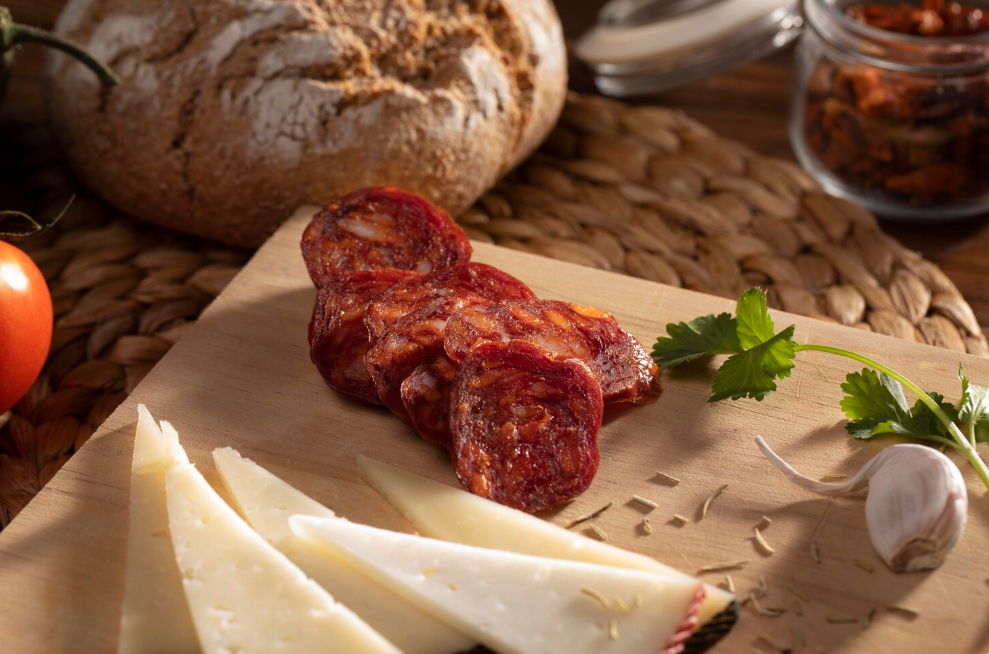Blog
soppressata: A Savory Slice of Italian Tradition

The world of cured meats is vast and varied, but few sausages carry the rustic charm and deep regional pride of soppressata. This Italian salume is more than just a food; it’s a story of tradition, terroir, and generations of artisanal knowledge passed down through families. Unlike its uniformly shaped cousin, salami, soppressata often boasts a distinctive, slightly flattened appearance, a testament to its name which hints at the pressing process it undergoes. Its flavor profile can range from gently sweet and aromatic to fiercely spicy, depending on the sun-drenched hills of Southern Italy it hails from. Discovering soppressata is like unlocking a delicious secret from the heart of Italian country life. Each slice offers a concentrated taste of history that is both robust and remarkably refined.
What is Soppressata?
Soppressata is a traditional Italian dry-cured sausage, a type of salume that holds a place of honor in Southern Italian cuisine, particularly in regions like Calabria, Apulia, and Basilicata. It is primarily made from choice cuts of pork, including the shoulder and ham, which are coarsely ground and generously seasoned with salt and pepper. The defining characteristic of many soppressata varieties, especially Soppressata di Calabria, is the inclusion of local chili peppers, which give it a signature heat. The mixture is then stuffed into natural casings, traditionally pork intestine, and left to cure for several weeks or months. This process concentrates the flavors and creates a firm, sliceable sausage that is rich, savory, and deeply satisfying.
The Origins and Regional Variations
The story of soppressata is deeply rooted in the concept of cucina povera, or the art of making do with what you have. Its origins lie in the rural tradition of the pig slaughter, where no part of the animal was wasted. The name itself is derived from the Italian word soppressare, meaning “to press,” referring to the historical practice of pressing the sausage under weights to remove excess air and moisture, resulting in its characteristic flattened shape. Regional variations are profound; Calabrian soppressata is famously spicy, while the version from Tuscany, known as soppressata toscana, is often a softer, spreadable meatloaf. Understanding these differences is key to appreciating the diversity within this single category of cured meat.
How Soppressata is Made
The creation of authentic soppressata is a meticulous craft that balances simplicity with skill. It begins with selecting high-quality pork, which is hand-cut or coarsely ground to maintain a rustic texture. The meat is then mixed with sea salt, black pepper, and often wine or vinegar, along with regional spices like chili flakes or fennel seeds. After being stuffed into its casing, the sausage is tied with twine at regular intervals. The crucial curing phase follows, where the soppressata is hung in a cool, well-ventilated cellar for a period that can last from a few weeks to over six months. During this time, beneficial molds often form on the casing, helping to develop its complex umami flavor and preserve it naturally.
Distinguishing Flavor and Texture
A well-crafted soppressata offers a multi-sensory experience that sets it apart from other cured meats. Its texture is firm yet tender, with a satisfying chew that gives way to a rich, fatty mouthfeel. The coarse grind ensures you can taste distinct pieces of pork, creating a more interesting eating experience than a finely emulsified sausage. Flavor-wise, it is intensely savory and pork-forward, with a beautiful balance of saltiness. The spice level can be a gentle warmth or a pronounced kick, depending on the variety, but it should always complement rather than overpower the meat. Notes of garlic, wine, and earthy spices linger in the background, making each slice a complex and delightful exploration.
Serving Soppressata in Modern Cuisine
While perfect on a classic antipasto platter, soppressata’s culinary uses have expanded far beyond the charcuterie board. Its bold flavor makes it an excellent ingredient for cooking, where it can infuse dishes with a deep, salty, and spicy backbone. Thinly sliced, it can be draped over pizzas or folded into warm pasta dishes, where its fat gently renders and coats the other ingredients. Diced soppressata creates a fantastic flavor base for soups, stews, and savory baked goods like scones or stuffings. It pairs wonderfully with eggs, can be tucked into sandwiches for a gourmet upgrade, or even used to wrap around other proteins before roasting.
Nutritional Profile and Considerations
As a cured meat, it is important to enjoy soppressata in moderation as part of a balanced diet. It is a calorie-dense food, rich in protein and fats, including saturated fat. It also contains a significant amount of sodium, which is essential for the curing process. However, it does provide some nutritional benefits, such as being a good source of Vitamin B12, zinc, and iron. Because it is a raw, cured product, individuals who are pregnant, elderly, or have compromised immune systems should exercise caution. For most people, savoring a few slices of soppressata as an occasional treat is a perfectly enjoyable way to partake in this traditional food.
Pairing Suggestions and Combinations
The robust character of soppressata calls for companions that can match its intensity or provide a refreshing contrast. On a cheese board, it pairs brilliantly with aged, sharp cheeses like Pecorino Romano or a creamy Gorgonzola. For drinks, a full-bodied red wine like a Nero d’Avola or a Chianti Classico stands up well to its spice, while a crisp lager or pale ale can cleanse the palate beautifully. To complete an antipasto spread, include sweet elements like fig jam or honey, tart pickled vegetables, and mild, creamy cheeses like fresh mozzarella. The key is to balance the salt, fat, and spice of the meat with contrasting textures and flavors.
Shopping for and Storing Soppressata
Finding quality soppressata is the first step to a great experience. Look for it at specialty Italian markets, reputable butcher shops, or the deli counter of high-end grocery stores. Seek out versions that specify their region of origin, as this is often a marker of authenticity. The casing should be tight and may have a natural, powdery mold, which is a sign of proper aging. Once purchased, whole, unsliced soppressata can be hung in a cool, dark place for several weeks. Once cut, it is best to store slices in the refrigerator, tightly wrapped in parchment paper and then plastic wrap, and consumed within a few days for optimal flavor and texture.
Soppressata vs. Other Cured Meats

It is easy to confuse soppressata with its more common relative, Genoa salami. While both are dry-cured sausages, they have distinct differences. Genoa salami is typically finely ground, yielding a more uniform texture, and is flavored with garlic and white wine, resulting in a milder, softer taste. Soppressata, by contrast, is coarsely ground, giving it a chunkier mouthfeel, and is often defined by the bold heat of chili peppers. Another key difference is the shape; salami is round, while soppressata is often pressed into an oblong form. Recognizing these subtleties helps you appreciate the unique place each holds in the world of charcuterie.
The Cultural Significance of this Salume
Soppressata is far more than a mere ingredient; it is a cultural touchstone. In Southern Italy, its production is often a communal, family event, tied to annual traditions and local festivals. It represents a direct link to the past and a way of life that values patience, quality, and seasonality. This sausage embodies the Italian principle of identità territoriale—the idea that a food’s identity is inextricably linked to its specific place of origin. The protected status of Soppressata di Calabria DOP ensures that these methods and traditions are preserved, safeguarding a piece of culinary heritage for future generations to enjoy and celebrate.
Conclusion
Soppressata stands as a powerful example of how simple ingredients, when treated with respect and expertise, can be transformed into something extraordinary. Its journey from a practical method of preservation to a celebrated gourmet item speaks to its enduring appeal. Whether you enjoy its spicy kick from Calabria or a milder version from another region, each slice offers a taste of Italian history and artisanal passion. Understanding its story, how it’s made, and the best ways to savor it only deepens the appreciation for this remarkable cured meat, making it a truly rewarding discovery for any food lover.
Frequently Asked Questions
What is the difference between soppressata and sopressata?
They are the same product; “soppressata” is the correct Italian spelling, while “sopressata” is a common English misspelling.
Does soppressata need to be cooked?
No, authentic dry-cured soppressata is ready to eat and is meant to be consumed uncooked, similar to other salamis.
Is soppressata very spicy?
It can be. Calabrian soppressata is typically quite spicy, but other regional varieties may be mild or seasoned with only black pepper.
How long does a whole soppressata last?
A whole, uncut soppressata can last for several months if stored properly in a cool, dry, and well-ventilated place.
Can I freeze soppressata?
It is not recommended, as freezing can degrade its texture and flavor. It is best stored at cool room temperature or refrigerated once sliced.
-

 Tech1 year ago
Tech1 year agoHow to Use a Temporary Number for WhatsApp
-

 Business2 years ago
Business2 years agoSepatuindonesia.com | Best Online Store in Indonesia
-

 Social Media1 year ago
Social Media1 year agoThe Best Methods to Download TikTok Videos Using SnapTik
-

 Technology1 year ago
Technology1 year agoTop High Paying Affiliate Programs
-

 Tech10 months ago
Tech10 months agoUnderstanding thejavasea.me Leaks Aio-TLP: A Comprehensive Guide
-

 FOOD1 year ago
FOOD1 year agoHow to Identify Pure Desi Ghee? Ultimate Guidelines for Purchasing Authentic Ghee Online
-

 Instagram3 years ago
Instagram3 years agoFree Instagram Auto Follower Without Login
-

 Instagram3 years ago
Instagram3 years agoFree Instagram Follower Without Login




















